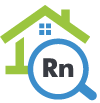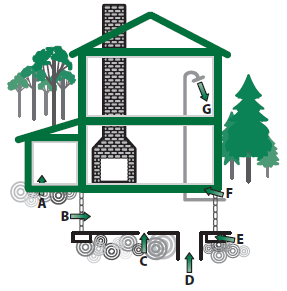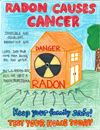Radon
Translate this page into other languages:

Homeowners in New York State can order a radon test from the State Department of Health for $12.25 by completing this order form.
Price includes test kit, analysis and postage to send the test kit to the laboratory.
Be sure to follow all test instructions. It very is important that the home is sealed up and all doors or windows to the outside are closed 24 hours before and during the entire testing period to ensure an accurate test. However, you can leave and re-enter your home.
- Track Radon Test Result Data in the Environmental Public Health Tracker. You can view maps, graphs and tables of radon test results in your county.
Radon is the leading cause of lung cancer among nonsmokers. You can’t see, smell or taste it, but radon could be present at a dangerous level in your home.
Radon is a naturally occurring, radioactive gas found in soil and rock that gets into the air you breathe. It seeps into buildings through cracks in the foundation, walls, and joints. It can get into any type of building--homes, offices, and schools. The greatest risk for exposure is where you spend most of your time – usually at home.
How Radon Enters the Home

- Cracks in concrete slab
- Pores and cracks in concrete blocks
- Slab-footing joints
- Exposed soil, as in sump
- Cracks between poured concrete (slab) and blocks
- Loose fitting pipes
- Water
Test Your Home for Radon
When to Test
- Every five years, or every two years if you have a radon mitigation system to make sure it’s working properly.
- During the winter months when your windows and doors can stay closed 24 hours before and during the entire testing period. However, you can leave and re-enter your home.
- When buying a home and after major renovations.
- Before buying a home, hire a certified radon testing professional. Check that the results of the test is will come from a laboratory approved through the State's Environmental Laboratory Approval Program.
- Check that the laboratory used to analyze the results is approved through the State's Environmental Laboratory Approval Program.
- Within 30 days of installing a radon mitigation system.
Understanding Your Test Results
New York State Health recommends fixing your home if the results of radon tests show levels of 4 picocuries per liter of air (pCi/L) or higher. With today's technology, radon levels in most homes can be reduced to 2 pCi/L or below. You also may want to consider fixing if the level is between 2 and 4 pCi/L.
Find out if radon levels are high in your town.
Fix a Radon Problem
A radon reduction system can reduce radon levels in your home by up to 99% and average cost is about $1,500. If your home has elevated levels of radon, contact a certified radon mitigator. More information is available at the U.S. EPA's Consumer's Guide to Radon Reduction.
Building Homes To Keep Radon Out
New construction methods keep radon out of the home by sealing soil gas entry points, by preventing radon gas from entering the home and by venting to release radon gas outdoors. Installing a radon reduction system during construction is easier and less expensive than installing a system after the house is completed. Every new home should be tested, even if it was built to be radon resistant. If radon levels are still at or above 4 pCi/L, a certified mitigator may activate the system by installing a fan.
More Information

Annual Radon Poster Contest
Congratulations to the 2023-2024 winners of the New York State Department of Health Radon Program's annual radon poster contest. View the winning posters and learn about how students can participate in the 2024-2025 contest.
Radon Professionals
The American Association of Radon Scientists and Technicians and the American National Standards Institute (AARST/ANSI) have developed National Radon Standards for radon testing and mitigation. These are the currently accepted standards and supersede previous EPA standards for radon.
Find Regional Radon Training Centers for continuing education.
Radon testing firms and mitigators must report testing results to the DOH. View Title 10 NYCRR 16.130 Radon Testing and Reporting for laws and regulations.
For Radon Testing Firms/ELAP Certified Laboratories:
Part 16 of the New York State Sanitary Code requires the reporting of County or Zip Code and number of measurements. You are only required to report the name of the laboratory in cases where the laboratory report the radon results to DOH.
For Radon Mitigators:
Part 16 of the New York State Sanitary Code requires the reporting of County or Zip Code and number of mitigations.
Please email radon@health.ny.gov or call (518) 402-7556 to request the Excel spreadsheet template for reporting your data.
Completed reports can be submitted via:
- Email to radon@health.ny.gov
- U.S. Postal Service to: Center for Environmental Health
Bureau of Environmental Radiation Protection
Empire State Plaza-Corning Tower, Room 1201
Albany, New York 12237
Medical Professionals
You can impact the health of New Yorkers by encouraging radon testing and mitigation, to help reduce the likelihood of radon induced lung cancer. Please consider:
- Making radon educational materials available in your waiting room.
- Displaying the "Have You Given Your Home a Radon Checkup?" poster.
- Including a question about home radon testing on your patient intake form.
- Scheduling a radon presentation for medical support staff by calling 518-402-7556 or by emailing radon@health.ny.gov.
- Providing patients with information about how low-cost test kits may be obtained from the Radon Program..
- Referring patients with more questions to the Radon Program.
These resources may also be helpful:
- The Conference of Radiation Control Program Directors, Inc., has developed a new guide for health care providers entitled Reducing the Risk from Radon: Information and Interventions. This guide was designed to furnish health care providers with the information they need to reduce their patients' exposures to radon.
- The Iowa Cancer Consortium has the Breathing Easier Campaign, which includes videos as well as educational fliers and pamphlets that can be customized for use in your practice. The webpage also has links to other radon resources for physicians.
- The Centers for Disease Control and Prevention (CDC) has developed a radon toolkit which contains graphics and customizable documents designed to educate on the risks of radon exposure.
- The Agency for Toxic Substances and Disease Registry (ATSDR) has developed a toxicological profile for radon, an ATSDR Clinician Brief: Radon (atsdr.cdc.gov) and Radon Case Study Environmental Medicine (CSEM) provides several radon training modules for continuing education credits.
- The Health Physics Society (HPS) is a scientific organization of professionals who specialize in radiation safety. The HPS develops position papers on various radiation topics, including radon.
- The New York State Comprehensive Cancer Control Plan was created by the NYS Cancer Consortium (NYSCC) and is meant as a guide to identify and address the cancer burden in NYS.
- Federal Radon Action Plan (FRAP) contains current federal government actions to reduce radon risks, and a series of new commitments for future action. These actions include providing resources and support to organizations and individuals and increasing awareness for builders and service industry professionals.
- The National Radon Action Plan (NRAP) represents a collaborative effort between eleven organizations dedicated to eliminating avoidable radon-induced lung cancer in the United States. Led by the American Lung Association, the national radon workgroup agreed on a framework for action aimed at incorporating radon testing, radon mitigation and radon-resistant construction into systems that govern purchasing, financing, constructing and renovating homes and other buildings.
- The Cancer Moonshot Report was delivered by former Vice President Biden in October 2016. The report summarizes the work of the Cancer Moonshot Task Force since its creation and lays out the Vice President's strategic plan for transforming cancer research and care. The report also includes the Cancer Moonshot Blue Ribbon Panel's identified areas of scientific opportunity.
- The World Health Organization (WHO) has developed a Handbook on Indoor Radon.
- The National Academy of Science, Biological Effects of Ionizing Radiation (BEIR) VI Committee has published a report on the Health Effects of Exposure to Radon.
- The US Environmental Protection Agency (EPA) has published an Assessment of Risks from Radon in Homes, EPA 402-R-03-003.
Day Care Providers
-
The New York State Office and Children and Family Services requires radon testing as part of an Environmental Hazards Assessment when applying to be a licensed daycare provider in certain areas of the state.
Radon Level Maps and Statistics
- Track Radon Test Result Data in the Environmental Public Health Tracker. You can view maps, graphs and tables of radon test results in your county.
Radon test results below can be viewed in different formats, charts, and datasets. This information is supported by Health Data NY.
- Detailed New York State Town Maps and Tables - These maps and data tables use measurement data, as well as other information, such as local geology.
NYS Radon Task Force
The NYS Radon Task Force was established by Chapter 414 of the Laws of 2018 to conduct a comprehensive study on the prevention of human exposure to radon and make recommendations to reduce and minimize exposure to New York State residents. The Council is chaired by the DOH.
Specific items to be addressed include:
- The need for interagency coordination of public education and outreach and prevention programs
- The need for training, education and possible licensing of radon services providers
- Any other related information that the commissioner of health may deem necessary or relevant in carrying out such study of radon in indoor settings
A report of the findings and recommendations of the task force and any proposed legislation necessary to implement such findings shall be filed with the governor, the temporary president of the senate, the speaker of the assembly, the minority leader of the senate, and the minority leader of the assembly on or before November 1, 2022.
Please contact radon@health.ny.gov for additional information.
The NYS Radon Task Force consists of the following members:
| Name | Seat Category |
|---|---|
| VACANT | Governor's Appointee – Real Estate Representative |
| George Schambach | Governor's Appointee – Radon Testing & Mitigation Expert |
| Richard Kornbluth | Temporary President of the Senate Appointee |
| VACANT | Speaker of the Senate Appointee |
| John Addario, Director – Division of Building Standards & Codes |
Secretary of State or Designee |
| Gary Ginsberg, Director – Center for Environmental Health |
DOH Commissioner or Designee |
| Selica Grant – Chief Risk Officer and Special Counsel |
DOL Commissioner or Designee (left July 25, 2022) |
| Darren Cohen – Deputy Commissioner for Policy, Strategy and Research |
DOL Commissioner or Designee (appointed July 25, 2022) |
Final Report
The approved NYS Radon Task Force Report (PDF) was transmitted to the governor and specified members of the legislature on January 12, 2024. Questions can de directed to the NYS Radon Program at radon@health.ny.gov.
PDF Meeting Information:
- Friday, July 22, 2022 Agenda and Minutes
- Thursday, June 30, 2022 Agenda and Minutes
- Tuesday, May 31, 2022 Agenda and Minutes
- Monday, April 25, 2022 Agenda and Minutes
- Friday, March 11, 2022 Agenda and Minutes
- Thursday, February 10, 2022 Agenda and Minutes
- Thursday, January 6, 2022 Agenda and Minutes
- Thursday, November 4, 2021 Agenda and Minutes
- Thursday, October 7, 2021 Agenda and Minutes
Resources
NYS DOH Resources
- Find Certified Radon Testers
- Find Certified Mitigators
- View and Order Radon Publications
- Radon Reduction Systems
- Radon-Resistant New Construction
- Annual Radon Poster Contest
US EPA Resources
- A Citizen's Guide to Radon
- Consumer's Guide to Radon Reduction
- Home Buyers and Sellers Guide to Radon
- National Radon Action Plan (NRAP)
- Radon Guide for Tenants
- Radon in Real Estate